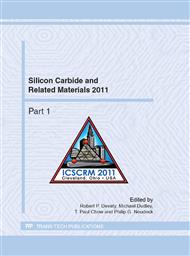p.259
p.263
p.267
p.271
p.275
p.279
p.285
p.289
p.293
Investigation of Additional States in the Silicon Carbide Surface after Diffusion Welding
Abstract:
This paper is a summary of the experimental study of deep levels in a SiC crystal lattice caused by diffusion welding (DW). Investigations were carried out by DLTS and Kelvin Probe methods. Investigations revealed that DLTS method is not applicable for identification of surface states. Research conducted by the Kelvin Probe method has shown an increase in the density of surface states after the diffusion welding from 2x1015 cm-2 to 3.5x1016 cm-2.
Info:
Periodical:
Pages:
275-278
Citation:
Online since:
May 2012
Authors:
Keywords:
Price:
Сopyright:
© 2012 Trans Tech Publications Ltd. All Rights Reserved
Share:
Citation:


